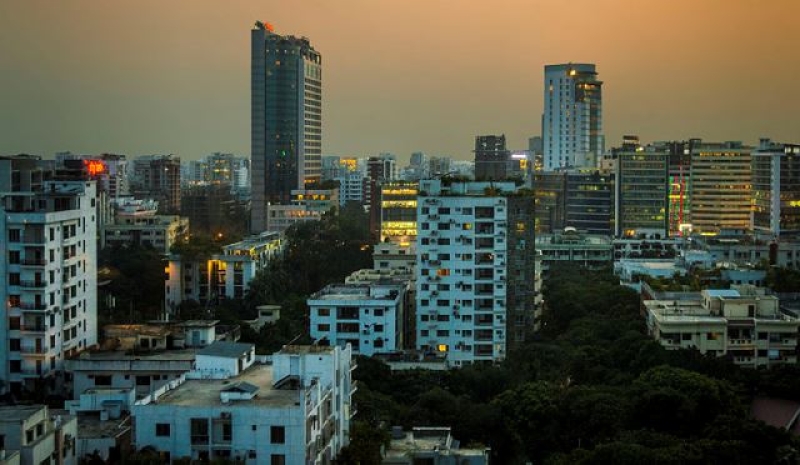- CA Yunus pays homage to Liberation War martyrs on Victory Day |
- Bangladesh capital market extends losing streak for second day |
- Bangladesh celebrates Victory Day Tuesday |
- 'Different govts presented history based on their own ideologies': JU VC |
Bangladesh on edge as earthquake threats escalating

The tremors were also felt across Nepal, India, Bhutan & China, highlighting the regional dimensions of such disasters.
Dhaka, Jan 07 - The tremors of a 7.1 magnitude earthquake that rattled the region on Tuesday morning serve as a stark reminder of Bangladesh's seismic vulnerabilities.
While no casualties have been reported in Bangladesh, the incident has brought renewed attention to the country’s readiness to confront a potentially catastrophic earthquake.
Experts warn that recent patterns—over 60 recorded quakes since 2024 alone—indicate an urgent need for comprehensive disaster preparedness.
Nestled at the junction of active tectonic plates, Bangladesh faces immense seismic risks. Its dense population, ageing infrastructure, and poor enforcement of building codes amplify these dangers, painting a grim picture for the future unless immediate action is taken.
The tremors were also felt across Nepal, India, Bhutan and China, highlighting the regional dimensions of such disasters.
A Nation on the Edge
Bangladesh’s position at the collision zone of tectonic plates, with several active fault lines, places it at significant risk. Historically, the region has experienced devastating earthquakes, with five major events between 1869 and 1930 registering above 7.0 on the Richter scale.
Since then, there has been a lull in high-magnitude quakes—a silence that experts caution could precede a seismic upheaval.
Recent years have seen a troubling rise in seismic activity. Among the 60 earthquakes recorded since 2024, three were above magnitude 4.0, while 31 ranged between 3.0 and 4.0. This uptick, coupled with urban sprawl and inadequate infrastructure, leaves the nation precariously exposed.
Dhaka: A City at Risk
Dhaka ranks among the 20 most vulnerable cities globally to earthquakes. The 2013 Rana Plaza collapse, which claimed over 1,100 lives, serves as a grim reminder of the dangers posed by poorly constructed buildings. A 2018 survey found that many structures in areas such as Mirpur, Mohammadpur, Pallabi, Rampura, Motijheel, and Khilgaon fail to meet structural and design standards.
Chattogram, the Chittagong Hill Tracts, and Jaintiapur in Sylhet are identified as extreme risk zones. A high-magnitude earthquake in these areas could unleash a disaster of unimaginable scale in Dhaka.
Sub-National Earthquake Risk Assessment
In March 2024, the Ministry of Disaster Management and Relief (MoDMR) launched Bangladesh’s first sub-national earthquake risk assessment, a proactive measure supported by the UN Office for Disaster Risk Reduction (UNDRR) and the Global Earthquake Model (GEM) Foundation.
This initiative integrates advanced probabilistic seismic hazard models, building exposure analyses, and fragility evaluations to map vulnerabilities and recommend actionable strategies.
Initial findings, shared during a four-day dissemination event in Dhaka, shed light on critical weaknesses.
Government officials, humanitarian organisations, and university students were briefed on historical seismicity, hypothetical scenarios, and infrastructure vulnerabilities. Thirty-five students received technical training on earthquake modelling, equipping the next generation to address these challenges head-on.
Unveiling Vulnerabilities
Key insights from the assessment reveal significant shortcomings:
Fragile Infrastructure: Hospitals, emergency response centres, and government offices are among the structures requiring urgent retrofitting to withstand seismic shocks.
Urban Planning Gaps: Poor enforcement of building codes and rapid, unplanned urbanisation heighten risks, particularly in densely populated areas like Dhaka.
Public Awareness Deficit: Many citizens remain unprepared for earthquake scenarios, with limited understanding of emergency protocols.
A Call to Action
While the sub-national assessment marks a crucial step forward, experts stress the need for a unified, multi-sectoral approach to mitigate risks. Key recommendations include:
• Strengthening and enforcing building codes.
• Conducting public awareness campaigns to educate communities on earthquake preparedness.
• Allocating resources to retrofit critical infrastructure.
• Enhancing civil-military coordination for efficient disaster response.
With proper implementation of the sub-national assessment’s recommendations, Bangladesh can transform its vulnerabilities into a robust defence against seismic threats.-UNB

